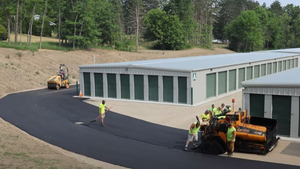Value-Add Projects for Self-Storage: Making Smart Upgrades That Yield a Positive Return
When it comes to making physical improvements at your self-storage facility, there’s always a temptation to focus on aesthetics. In actuality, you want to invest in projects that’ll positively impact net operating income and facility value. Here’s guidance to help you make smart decisions with a good return.

In residential real estate, there’s a phenomenon known as “over rehabbing.” It’s an odd concept because you’d think that the more you improve a property, the more its value would increase. Unfortunately, as many fix-and-flippers and overzealous homeowners have discovered, not every dollar spent on exotic hardwoods or a living-room hot tub results in the expected return on investment.
News flash: As a commercial asset, self-storage isn’t immune to this phenomenon!
Per standard commercial valuation, capitalization (cap) rate is one of the methodologies used to establish the value of a self-storage facility and needs to be at the forefront of decision-making when approaching value-add projects. Though there may not be many renovation options available for simple storage structures, there are ample opportunities to spend money in ways that won’t necessarily increase property value.
When it comes to making physical improvements, you need to be smart. Invest in upgrades that make sense, not just from an aesthetic perspective, but financially, for the short and long term. Following is some guidance.
A Formulaic Approach
The beauty of facility improvements is there’s a return multiple for every dollar of increased net operating income (NOI). Cap rate is calculated by dividing NOI by value or price. If a self-storage property trades at an 8% cap, for every $1 that NOI increases, facility value grows $12.50.
$1.00 / .08 = $12.50
Any upgrades that effect the trading cap rate also result in a return multiple. By improving a property’s class ranking, say from a C to a B, the cap rate will decrease. If a facility with NOI of $100,000 is improved so someone will buy it at a 7% cap as opposed to 8%, there’s a profit increase of more than $178,000.
$100,000 / 0.08 = $1,250,000
$100,000 NOI / 0.07 = $1,428,571
$1,428,571 - $1,250,000 = $178,571
When considering value-add projects for your self-storage facility, any investments that can improve asset class and increase NOI should be prioritized. For example, taking traditional units and converting them into climate-controlled spaces could result in rental-rate increases as well as a better class. The increased utility expense would prevent you from capturing 100% of the rate increase, but if due diligence provides the basis for an overall positive impact on NOI, then it’s doable.
Let’s say that adding climate control results in a 25% increase in NOI, from 100,000 to $125,000. If that $25,000 also improves the asset class and compresses the cap rate from 8% to 7%, it increases the overall valuation by more than $535,000. If that $25,000 doesn’t change the asset class, it’ll only increase the valuation by $312,500. Pending the cost of conversion, that juice is most likely worth the squeeze.
$100,000 / 0.08 = $1,250,000
$125,000 / 0.08 = $1,562,500
$125,000 / 0.07 = $1,785,714
$1,785,714 - $1,250,000 = $535,714
$1,562,500 - $1,250,000 = $312,500
Value, Not Vanity
Focusing on facility appearance is the easiest way to lose money during a value-add project, as it doesn’t directly improve the commercial valuation and may not upgrade the asset class. Painting doors and improving the landscape may make your self-storage property look nicer, but it isn’t enough to elevate it from class C to B.
However, if a lack of new paint and untamed landscaping results in customers not wanting to rent there, then improving those items will result in an increase to NOI and, thusly, valuation. The good news is, unlike with residential assets, utility is what most customers are looking for in a storage facility, not trimmed hedges and azaleas.
That said, there are some functional items that’ll improve appearance and carry more benefits than an indirect valuation increase. For example, paving and fencing may or may not attract more customers, and most likely won’t justify increased rental rates, as those are typically expected site features and not considered amenities by customers. Still, pursuing such a project could bump up the asset class, resulting in a value increase through cap-rate compression. In addition, an overlooked benefit to this type of project is lendability.
Some self-storage loans carry physical requirements. For instance, commercial mortgage-backed securities loans have some of the most favorable terms on the market but usually require that a facility be paved and fenced. These loans also carry a minimum amount in the millions. If a property qualifies for a loan and that loan is assumable by a new owner, then it can increase the price a buyer is willing to pay. A favorable mortgage may not increase the explicit value of the facility from a sales-price perspective, but it will result in a higher cash-on-cash return.
Protecting Value
Property improvements aren’t just about increasing value but maintaining it. All too often, self-storage is treated as a “set it and forget it” investment. While this strategy can work for a while, entropy will inevitably ensue, and value will decrease over time by outpacing inflation and appreciation. For owners, resisting the urge to defer maintenance protects facility valuation. When timing a sale, maintenance events can capture a higher price.
The prevalence of deferred maintenance is high among “mom and pop” owners, who account for the majority of class-C and -B facilities. This provides an opening for buyers to acquire these sites and benefit from immediate value-add opportunities, since the majority of physical improvements will result in an increase in equity (if purchased smartly).
That said, adding exotic hardwood or a hot tub to your self-storage facility still won’t result in a return on investment! So, weigh your options carefully and invest wisely. Choose value-add projects based on how positively they affect the asset from a financial point of view.
Steven Wear is chief marketing officer and director of acquisitions at Impact Self Storage, which buys and develops storage facilities nationwide, and vice president of Titan Wealth Group, which sources and syndicates off-market storage deals across the country. He graduated from the University of Illinois at Urbana-Champaign and lives in Chicago. For more information, email [email protected].
About the Author(s)
You May Also Like







